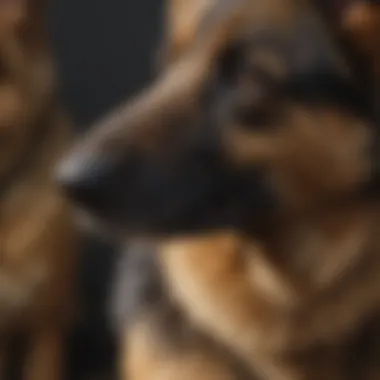Mastering the Shedding Season of German Shepherds


Intro
German Shepherds are one of the most popular dog breeds, known for their intelligence, loyalty, and versatility. While they make amazing companions, their shedding can often present challenges for pet owners. Understanding the shedding season of German Shepherds is essential not only for maintaining your home but also for ensuring the health and comfort of your pet.
This article explores various aspects of shedding, providing insight into why it happens and how owners can effectively manage it. By recognizing the biological patterns and adopting appropriate grooming techniques, owners can foster a well-maintained coat and a healthier dog. This guide seeks to equip pet owners with the knowledge they need to navigate the seasonal shedding cycles, improving both pet well-being and owner satisfaction.
Animal Overview
Common Names
The German Shepherd is often referred to simply as the "GSD". Other nicknames include the Alsatian or the police dog, as they are frequently employed in law enforcement and security due to their keen senses and intelligence.
Scientific Classification
In the scientific hierarchy, the German Shepherd falls under:
- Kingdom: Animalia
- Phylum: Chordata
- Class: Mammalia
- Order: Carnivora
- Family: Canidae
- Genus: Canis
- Species: Canis lupus familiaris
Geographic Range
Originally bred in Germany for herding and protection duties, German Shepherds are now found in various parts of the world. They thrive in diverse climates but are best-suited for temperate regions where their double coat can provide insulation against cold weather. Their adaptability contributes to their widespread popularity in households globally.
Shedding Patterns
Understanding the shedding patterns of German Shepherds is crucial. These dogs typically shed their undercoats twice a year, during the spring and fall seasons. The spring sheds the heavier winter coat, making way for lighter summer fur, while the fall shedding prepares them for a warmer winter coat.
Factors Influencing Shedding
Several factors can affect the shedding process:
- Genetics: Individual hereditary factors can lead to variations in shedding.
- Health: A dog’s health can determine coat quality and shedding levels.
- Nutrition: A balanced diet rich in fatty acids influences skin and coat conditions.
Managing shedding involves not only understanding seasonal patterns but also recognizing these influencing factors. This knowledge allows owners to take proactive steps to reduce shedding and promote a healthy coat.
Prologue to Shedding in German Shepherds
Understanding shedding in German Shepherds is more than a matter of aesthetics; it is essential for both the health of the dog and the comfort of the owner. Shedding is a natural process that reflects the overall state of a dog's coat and health. Recognizing the shedding patterns of this breed can enable pet owners to better manage their dog's needs.
Importance of Understanding Shedding
Shedding serves several purposes. Firstly, it helps regulate body temperature. German Shepherds have a dense double coat, which traps heat. In warmer months, shedding assists in cooling down the dog. Secondly, shedding allows for the renewal of fur. Over time, older and damaged hairs must be replaced to maintain a healthy coat.
In addition to health reasons, understanding shedding is significant for practical care. Pet owners can develop effective grooming routines that align with shedding patterns. Regular grooming reduces the amount of fur left around the house, leading to a cleaner living environment.
Additionally, recognizing shedding seasons alerts owners to potential health issues. Abnormal or excessive shedding may indicate underlying health problems, such as allergies or skin conditions. Thus, observing how much and when a German Shepherd sheds could give valuable insights into their general well-being.
"Shedding is not just a nuisance; it is an indicator of a dog’s health. Being observant can prevent future complications."
In summary, being knowledgeable about the shedding process is crucial for fostering a healthy environment for both the dog and the owner. With the right approach, shedding can be managed effectively, enhancing the quality of life for both parties.
The Shedding Process Explained


Understanding the shedding process is crucial for any German Shepherd owner. Shedding is a natural occurrence that signifies the health and vitality of the dog. Knowing how and why shedding takes place enables owners to deal with it effectively, minimizing the impact on both the pet and living space. This section will explore the causes of shedding, focusing on specific elements such as hormonal changes, seasonal patterns, and environmental factors. Additionally, the insights into coat type variations will shed light on the differences among individual dogs and their grooming needs.
What Causes Shedding?
Shedding in German Shepherds can be attributed to various factors. Firstly, hormonal changes are a significant cause. As dogs age or go through changes like pregnancy, their hormone levels fluctuate, prompting alterations in their coat. Moreover, seasonal shedding is another known trigger. German Shepherds are known to experience heavier shedding in spring and fall as they adapt to changing temperatures. This is called "blowing the coat."
Environmental influences can also stimulate shedding. Factors such as indoor heating during winter or increased humidity in summer disrupt the natural shedding cycle, causing additional hair loss.
Furthermore, stress can serve as a catalyst. A new environment, additional pets, or changes in routine can result in increased anxiety for the dog, leading to accelerated shedding.
It is essential for pet owners to recognize these causes as part of the normal lifecycle of their dogs.
The Role of Coat Type
The coat type of German Shepherds plays a critical role in determining how much they shed. These dogs typically have a double coat, consisting of a dense undercoat and a longer outer coat. The undercoat serves as insulation and traps loose fur, shedding seasonally to adapt to temperature changes. The outer coat protects against the environment and also sheds at a slower pace.
The texture and length of the coat can vary significantly among individual German Shepherds. Some may have coarser fur while others possess a finer texture. These variations affect how shedding occurs and the grooming methods that should be implemented.
Pet owners may also notice differences in shedding between male and female German Shepherds, primarily due to hormonal influences. Males may shed more during the times of hormonal shifts, particularly after neutering or during estrus in females.
In summary, understanding the specific coat type and its implications can greatly assist owners in managing shedding effectively.
Seasonal Shedding Patterns
Understanding seasonal shedding patterns is crucial for German Shepherd owners. This knowledge not only helps to manage the shedding effectively but also enhances the bond between the owner and the pet. Regular shedding is a natural biological process that ensures the dog's coat remains healthy and suited to its environment. By being aware of these patterns, owners can prepare for the increased shedding periods and take appropriate steps to care for their pets.
When Does Shedding Occur?
Shedding in German Shepherds predominantly occurs in spring and fall. During spring, dogs shed their heavier winter coat to allow for lighter fur that is more comfortable in warmer temperatures. Similarly, in the fall, they lose their summer coat to make way for a denser winter fur. This cyclical pattern is influenced by daylight hours and temperature changes. Understanding this cycle helps owners anticipate the shedding periods and take proactive measures in grooming.
Factors such as age, health, and genetic predisposition also contribute to the timing and amount of shedding. Puppies tend to shed less than adult dogs, while older dogs may exhibit varying shedding patterns. Regular observation of shedding can aid in understanding an individual dog’s unique cycle.
Variability by Climate
Climate plays a significant role in shedding patterns as well. German Shepherds living in temperate climates experience more pronounced seasonal shedding due to distinct changes in temperature. For example, a dog in a colder region may shed more fur during the transition to winter than a dog in a tropical climate.
In contrast, dogs residing in warmer areas may shed year-round, but the amount may not be as extensive as during seasonal changes in colder climates. Owners in these regions should be mindful of their dog’s coat condition and may need to adjust grooming strategies accordingly.
Factors such as humidity can also affect shedding. Higher humidity can lead to shedding not conforming to the typical seasonal patterns. This variability highlights the importance of closely monitoring a pet's coat throughout the year and adjusting care routines to maintain optimal health and comfort.
In summary, owners need to familiarize themselves with these patterns, as it aids not only in coping with the shedding but also ensures a supportive environment for their German Shepherds.
Factors Influencing Shedding
Understanding the factors influencing shedding is essential for any German Shepherd owner looking to manage their pet's coat effectively. Shedding is not merely a seasonal nuisance; it reflects the dog's overall health, genetic makeup, and lifestyle choices. Identifying the key components that contribute to shedding can enable owners to mitigate its effects and promote a healthier coat. Let’s explore these factors in detail.
Genetic Factors
Genetics play a significant role in determining how much a German Shepherd will shed. Each dog inherits specific traits from its parents, including the density and quality of its coat. Some individuals may have a thicker undercoat that is prone to more shedding, especially during seasonal changes.
Moreover, certain lines of German Shepherds are bred for specific purposes, such as show or work. These distinctions may also influence shedding patterns. For example, working German Shepherds in colder climates might have a heavier coat and shed more during seasonal changes than show lines accustomed to milder weather.
Overall, being aware of your dog's lineage can provide insights into potential shedding levels and help set realistic expectations.


Health and Shedding
Health status is another critical factor that impacts shedding. Dogs with underlying health issues may experience excessive shedding, often as a side effect of stress or discomfort. Skin conditions, allergies, or hormonal imbalances can contribute to an increase in hair loss.
Owners should be vigilant for signs of abnormal shedding—such as bald patches or skin irritation. These may indicate that your German Shepherd requires veterinary attention. Regular check-ups can help address health concerns before they escalate, promoting better coat condition in the long run.
Dietary Impact on Shedding
The dog’s diet is equally important. A balanced diet high in essential fatty acids can improve skin health and reduce shedding. Foods rich in Omega-3 and Omega-6 fatty acids support skin hydration and overall fur quality.
It's also crucial to consider the quality of dog food. Low-quality food often lacks vital nutrients, which may contribute to poor coat health and increased shedding.
Owners should consult with veterinarians to ensure their German Shepherd's diet is nutritionally complete and tailored to their specific needs. Little changes in diet can result in noticeable improvements in shedding patterns.
A proper diet not only improves the coat but also enhances the overall well-being of the dog.
Understanding these factors enables more effective management of shedding. By considering genetics, health, and diet, owners can take proactive steps to minimize shedding and ensure that their German Shepherd thrives.
Grooming Techniques for Managing Shedding
Grooming is an essential component in managing shedding during the German Shepherd shedding season. Effective grooming not only helps to minimize the amount of loose hair in the home, but it also contributes to the overall health of the dog's skin and coat. Understanding the right techniques and tools for grooming can make a significant difference in the comfort of both the pet and owner.
Best Tools for Grooming
Choosing the appropriate grooming tools is crucial for effectively managing a German Shepherd's shedding. Some tools are designed specifically for the needs of this breed, which has a double coat that sheds significantly.
- De-shedding Tool: Tools like the Furminator or the Hertzko Self Cleaning Slicker Brush are popular. They are designed to reach through the topcoat and remove the undercoat fur without damaging the skin.
- Undercoat Rake: This tool is ideal for removing loose fur from the dense undercoat. It helps to prevent matting and promotes a healthy coat.
- Rubber Grooming Mitts: These mitts are effective for removing loose hair while providing a gentle massage for your pet. This can make the grooming experience more enjoyable for your dog.
- Nail Clippers: Regularly clipping nails is also a part of grooming. While it doesn't affect shedding directly, it contributes to the overall health and comfort of the dog.
"Choosing the right grooming tools is critical to effectively manage shedding and ensure the comfort of your German Shepherd."
Establishing a Grooming Routine
A well-established grooming routine can help you stay on top of shedding. Consistency is key and helps to condition your dog to the grooming process.
- Frequency: During peak shedding seasons, grooming should occur at least two to three times a week. Outside shedding seasons, once a week is generally sufficient.
- Timing: Choose a time when your dog is calm, such as after a walk or play session. A comfortable setting will make the process smoother.
- Grooming sessions: Each session should last between 10 to 20 minutes. This keeps the dog engaged without causing boredom or anxiety.
- Positive reinforcement: Reward your dog with treats or praise during and after grooming. This helps to associate grooming with positive experiences.
Health Considerations During Shedding
Understanding the health considerations during shedding is crucial for all German Shepherd owners. Shedding is not only a natural process but sometimes can indicate underlying health issues. Recognizing the signs of abnormal shedding can lead to early detection of potential problems, ensuring that your pet remains healthy. By observing their dog's shedding patterns, owners can make informed decisions about care and consult the appropriate professionals when necessary.
Recognizing Abnormal Shedding
Abnormal shedding in German Shepherds can manifest in various ways. Healthy shedding typically leads to the loss of hair in a controlled manner, parallel to the seasonal changes in their environment. However, several indicators may suggest that the shedding is beyond the normal range.
Look for these signs:
- Excessive Hair Loss: If your dog is shedding much more than usual, this could be a cause for concern.
- Bald Patches: Areas without fur can represent health issues and require prompt attention.
- Skin Irritation: Red or inflamed skin may indicate allergies or other dermatological conditions.
- Changes in Coat Texture: An alteration in the feel or appearance of the coat could suggest health issues.
Regularly monitoring your German Shepherd's coat can help in identifying abnormal shedding early. If you notice any of these signs, taking action is essential.
When to Consult a Veterinarian
Knowing when to seek veterinary advice is essential for maintaining your German Shepherd's overall health during shedding periods. Consulting a veterinarian is advisable under the following circumstances:


- If the shedding is accompanied by other symptoms, such as lethargy, loss of appetite, or behavioral changes.
- When you observe persistent scratching or biting at the skin, which can signify allergies or parasites.
- If your dog develops bald spots, scabs, or any skin abnormalities.
- If the shedding continues outside of typical seasonal patterns or does not lessen post-shedding season.
Early intervention can lead to better health outcomes for your pet. Regular veterinary check-ups can help catch potential issues before they escalate, ensuring your German Shepherd remains robust and vibrant throughout their shedding seasons.
Environmental Influences on Shedding
Understanding the environmental influences on shedding is essential for German Shepherd owners. The surroundings where pets live can significantly impact their shedding patterns, making it a critical topic in managing a healthy coat. Various elements such as the home environment, climate, and seasonal changes play a role. By adjusting these factors, pet owners can lessen the amount of hair shed and enhance their dog's overall comfort.
Home Environment and Shedding
The home environment is one of the foremost factors influencing shedding. Factors like temperature, humidity, and cleanliness can affect how much hair a German Shepherd will lose. For instance, a very warm or dry indoor climate can lead to excessive shedding, as dogs may adapt to regulate their body temperature. Frequent vacuuming and cleaning surfaces where the dog spends a lot of time can help manage the pet dander and hair that accumulates in the home.
Additionally, providing a designated space for the dog can make a difference. A separate area for rest that is easy to clean can contain the shedding to specific locations. Using washable covers for furniture can simplify this process, making it easier to maintain a clean living space while accommodating your pet's needs.
"A clean environment can lead to a happier dog, which may reduce shedding."
Seasonal Adjustments to Living Spaces
Seasons also greatly affect shedding, and small adjustments within the living space can help. During periods of higher shedding, typically in spring and fall, pet owners may want to increase the frequency of grooming to keep loose fur at bay. Regular cleaning protocols, such as dynamic airflow for ventilation, can reduce the impact of shedding by improving indoor air quality.
Moreover, considering the dog's presence in various rooms during different seasons can be beneficial. In winter, they may need more warmth, hence using heated blankets or coats can minimize stress, leading to potentially less shedding. In contrast, during hotter months, providing a cooler space with fans or air conditioning will keep the dog comfortable and possibly reduce the volume of fur they shed. By paying attention to these seasonal changes and making necessary adjustments in their home environment, pet owners can help mitigate the effects of shedding.
Long-term Management Strategies
Long-term management strategies are essential for understanding and addressing the shedding season of German Shepherds. These strategies not only help in mitigating the impact of shedding but also contribute to the overall health of the dog. Effective management requires a holistic approach that considers various aspects such as diet, grooming, and routine veterinary care. By implementing these strategies, pet owners can create an environment that supports a healthy coat while minimizing discomfort caused by excess shedding.
Nutritional Adjustments
Diet plays a critical role in the hair growth cycle of German Shepherds. Nutritional adjustments can help regulate shedding and enhance coat health. It is important to provide a balanced diet that is rich in essential fatty acids. Foods that contain Omega-3 and Omega-6 fatty acids can improve skin health and reduce shedding.
- Look for high-quality dog foods that list real meat as the first ingredient.
- Supplementing the diet with fish oil or flaxseed oil can also be beneficial.
- Ensure adequate hydration, as it supports skin integrity.
Incorporating a variety of proteins into their diet can prevent deficiencies that lead to poor coat conditions. Monitoring the dog's weight is also important; obesity can exacerbate shedding problems. Regularly consulting with a veterinarian about dietary choices will ensure that the dog's specific nutritional needs are met, thus promoting better coat management.
Regular Veterinary Check-ups
Regular veterinary check-ups should be a crucial part of any long-term management strategy for German Shepherds. These visits allow for comprehensive assessments which can unveil underlying health issues contributing to excessive shedding. Early detection of medical problems can lead to timely interventions, often preventing further complications.
Pet owners should schedule routine visits to monitor the overall health of their dog:
- Discuss any changes in shedding patterns with the veterinarian.
- Keep track of vaccinations to avoid diseases that might affect skin or fur.
- Ask about potential allergies or skin conditions that can exacerbate shedding.
Veterinarians can provide tailored advice based on the specific needs of each dog, which can greatly influence the effectiveness of shedding management. By prioritizing frequent health evaluations, owners can remain proactive in maintaining their pet's wellness.
Epilogue
The shedding season in German Shepherds is not just an annual occurrence; it significantly affects both the dog and its owner. Understanding this topic provides insights into managing this natural process effectively. Awareness of shedding patterns can help owners anticipate high-shedding periods, which typically correlate with seasonal changes. This knowledge allows for proactive grooming and environmental adjustments, leading to a more harmonious home for both pet and human.
The Balance of Care and Understanding
Care for a German Shepherd goes beyond basic needs. It encompasses a deeper understanding of their biological processes, particularly shedding. Owners who recognize the science behind shedding can take actionable steps to mitigate its impact. For instance, regular grooming can improve coat health and minimize loose fur around the house.
Moreover, a balanced diet plays a vital role in reducing excessive shedding. Providing high-quality nutritional options, enriched with essential fatty acids, can enhance coat condition, consequently lowering the amount of fur shed.
"Understanding leads to compassion; compassion yields better care."
Veterinary visits should also not be overlooked. They serve as essential checkpoints to ensure the overall health of a German Shepherd. Abnormal shedding may indicate underlying health issues that require attention. Keeping regular appointments can catch such concerns early.
In summary, the shedding season is an integral part of owning a German Shepherd. By balancing effective care with a thorough understanding of the shedding process, owners can cultivate a nurturing environment. This approach not only benefits the dog’s health but also significantly enhances the experience of pet ownership.







